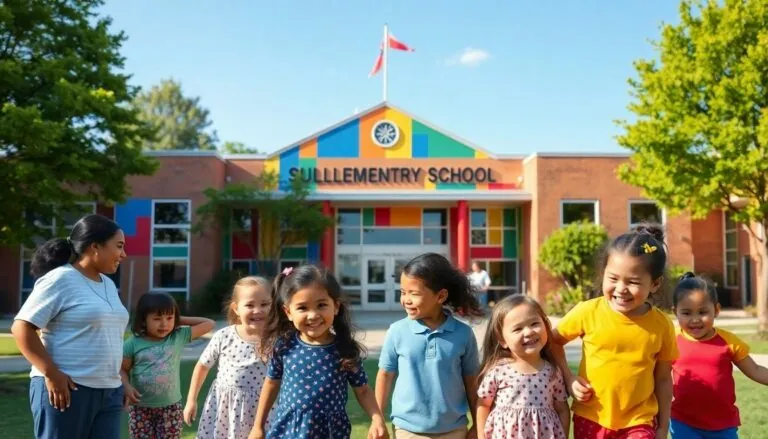Table of Contents
TogglePublic preschool isn’t just a place for kids to color outside the lines; it’s the launchpad for their future adventures in learning. Imagine a world where your little ones dive into a treasure trove of knowledge, make their first friends, and develop skills that’ll have them ready to conquer kindergarten like tiny superheroes. It’s not just about playtime; it’s about laying the foundation for lifelong learning.
Overview of Public Preschool
Public preschool serves as a foundational step in early childhood education. Programs often cater to children aged three to five, emphasizing social skills, emotional development, and cognitive growth. Quality public preschools frequently focus on play-based learning, allowing children to explore their interests in a nurturing environment.
Curricula may include structured activities, such as storytelling, art, and basic math concepts. Teachers guide children through these experiences, fostering curiosity and a love for learning. Benefits of public preschool extend beyond academics; they promote socialization, teaching children to interact with peers and develop friendships.
Financial accessibility adds to the appeal of public preschool. Many states provide tuition-free or low-cost options, making early education reachable for families regardless of income. Enrollment numbers reflect growing interest; in 2020, approximately 52% of U.S. children attended public preschool programs.
Public preschool effectively prepares children for their transition to kindergarten. Research indicates that children who attend preschool tend to perform better academically and socially compared to those without early education experiences. Their foundational skills often translate into enhanced learning outcomes in later grades.
Overall, public preschool represents a critical service in the educational landscape. Parents recognize its role in shaping children’s futures, prompting ongoing support and advocacy for access to quality early education. Initiatives continue to promote awareness about the importance of early childhood experiences, reinforcing public preschool’s significance in the life of a child.
Benefits of Public Preschool
Public preschool offers many advantages that foster children’s overall development. These programs provide essential early educational experiences that benefit both academic and social growth.
Academic Advantages
Academic gains are significant for children enrolled in public preschool. Studies show that individuals in these programs score higher on standardized tests. Research highlights that children experience improved literacy and numeracy skills early on, leading to stronger performance in elementary school. Curriculum focuses on interactive learning through play, allowing children to absorb new concepts naturally. Engaging activities stimulate critical thinking, preparing them for more complex subjects. Numbers illustrate the effectiveness, with data indicating that children who attend preschool are 25% more likely to excel in reading by third grade. This solid foundation sets the stage for a successful educational journey.
Social Development
Social skills flourish in public preschool environments. Children learn to interact with peers through structured group activities. Engagement in collaborative play helps them develop communication skills essential for building friendships. Conflict resolution is practiced, teaching them how to navigate disagreements effectively. Research confirms that children who attend preschool are better prepared for social experiences in elementary school. Approximately 70% of these young learners show improved cooperation and teamwork abilities. These foundations promote emotional intelligence, creating well-rounded individuals who adapt to diverse social settings.
Challenges Facing Public Preschool
Public preschool systems face significant challenges that impact their effectiveness and reach. Understanding these obstacles is crucial for improving early childhood education for all children.
Funding Issues
Funding issues remain a primary challenge for public preschool programs. Many states grapple with tight budgets that limit resources allocated to early childhood education. Competing priorities in education often push preschool funding down the list. Inadequate financing affects teacher salaries, classroom materials, and facility maintenance. According to national data, only around 28% of public preschools receive adequate funding to meet quality standards. Insufficient budgets can also lead to larger class sizes, negatively impacting individualized attention for children. Funding disparities affect program quality and availability, leaving many potential preschoolers without access to essential early education experiences.
Accessibility Concerns
Accessibility concerns hinder broad participation in public preschool programs. Geographic limitations contribute to inequitable access, particularly in rural areas where facilities may be sparse. Families often encounter logistical issues such as transportation or scheduling conflicts that affect enrollment. Approximately 20% of eligible children, particularly those from low-income households, remain unenrolled due to these barriers. Limited hours of operation can exacerbate these challenges, making it difficult for working parents to find suitable options. Expanding funding and resources can help alleviate these accessibility issues, ensuring that all children have the opportunity for quality preschool experiences.
Comparing Public Preschool with Private Options
Comparing public preschool with private preschool options reveals essential differences. Public preschools often offer tuition-free or low-cost enrollment, making them accessible for families of various incomes. Approximately 52% of U.S. children attended public preschool programs in 2020, showcasing its popularity among parents seeking early childhood education.
Private preschools typically charge tuition. This cost can range significantly based on location and program offerings, limiting accessibility for low-income families. Private options often tout smaller class sizes, potentially allowing for more individualized attention. However, around 28% of public preschools receive adequate funding, posing challenges in maintaining quality due to larger class sizes and resources.
Curricula in public preschools focus on play-based learning, promoting social skills and emotional development. Engaging activities encourage curiosity and enjoyment of learning. In contrast, some private preschools may emphasize academic readiness, which might put pressure on young learners.
Socialization experiences vary as well. Public preschools foster peer interaction through structured group activities, leading to improved communication and conflict resolution skills. Research indicates that 70% of preschoolers in public settings demonstrate enhanced cooperation and teamwork abilities. Private options may also offer social experiences but could lack the same level of diversity in peer interactions.
Ultimately, public preschool serves as a foundational step in children’s education, emphasizing accessibility and community engagement. Parents often recognize the importance of early educational experiences, leading to advocacy for more public preschool resources. Expanding access to quality early education remains crucial for supporting children’s development and enhancing learning outcomes, setting the stage for success in future education.
Key Programs and Models
Public preschool programs encompass various models designed to cater to the diverse needs of children and families. Many public preschools implement the HighScope model, emphasizing active participatory learning. Children explore concepts through hands-on activities, fostering engagement and enthusiasm for learning.
Another notable model is the Montessori approach, which encourages self-directed learning in a prepared environment. Children choose activities that interest them, enhancing their independence and critical thinking skills. This method promotes a love for discovery, an essential aspect of their cognitive growth.
Head Start is a well-known federal program targeting low-income families. It provides comprehensive services, including education, health, and nutrition support, ensuring that children are ready for kindergarten. Approximately 1 million children benefit from Head Start annually, highlighting its significance in early education.
Public preschools frequently adopt state pre-kindergarten programs designed to prepare children for school readiness. Each state outlines its curriculum and requirements, often incorporating elements like play-based learning and structured activities. Data from 2020 indicated that 52% of U.S. children attended some form of public preschool, reflecting a strong interest in these educational initiatives.
Despite commonalities, programs differ in class size and teacher-to-student ratios. Public preschools often struggle with larger class sizes due to funding constraints. Smaller groups observed in private preschools can result in more individualized attention, a factor families may consider when choosing the right fit.
In addition to structured activities, public preschools emphasize socialization. Children learn cooperation and conflict resolution through group interactions, enhancing their communication skills. Research shows that 70% of preschoolers demonstrate improved teamwork abilities, crucial for their future educational experiences.
Overall, public preschool programs aim to provide accessible, quality education, prioritizing early childhood development and community engagement.
Conclusion
Public preschool stands as a vital component of early childhood education. It not only nurtures children’s academic skills but also fosters social and emotional development. By providing accessible, play-based learning environments, public preschools equip children with the tools they need to thrive in future educational settings.
Despite challenges such as funding and accessibility, the importance of these programs cannot be overstated. They play a crucial role in leveling the playing field for families across various income levels. As awareness grows about the benefits of early education, the push for better funding and resources becomes essential. Ensuring that every child has access to quality preschool experiences is key to building a brighter future for all.








